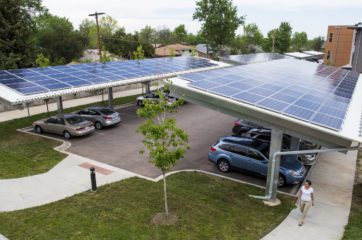The 2020 Oregon legislative session just ended with yet another Republican walkout, once again halting the passage of cap-and-invest legislation.
In late February, Senate Bill 1530 made it to the Senate floor. However, Republican Senators refused to attend the vote, prompting a GOP-led boycott of the session.
Read our coverage of Oregon’s last Republican walkout.
The bill was a revised version of House Bill 2020, proposed in 2019, which also did not pass due to Republican Senators fleeing the Capitol. The bill would have set a declining cap on heat-trapping gas emissions in the state, and redistribute revenue to the Transportation Decarbonization Investments Account and the Common School Fund. This year’s bill had provisions to protect rural Oregonians from prices increasing too quickly, a major concern Republican lawmakers had with the original bill.
Why does this keep happening?
Unlike other states, Oregon’s state constitution has a provision in Article IV, Section 12 that sets a legislative quorum at two-thirds of the legislative body, meaning that if the minority party decides to not be present by walking out, business as usual cannot occur. While many other states have quorums, most are set at a simple majority, prohibiting walkouts such as these from occurring.
While this has always been a part of the state’s law, it had been an unspoken rule that neither party would flee while in the minority. That changed last year over the first cap-and-invest bill.
When Senators refuse to show up to their jobs, they waste taxpayer dollars and prohibit any legislation, not only cap-and-invest, from being passed. This year, the walkout was especially harmful, as legislation was needed to address extreme flooding in eastern Oregon that forced many families out of their homes (which was caused by the warming climate).
“Right now this legislature is not functioning. I never thought I would see this day because of the idea this is going to be the new norm of how you kill a bill,” said Senate President Peter Courtney.
Courtney also stated that he would consider changing the quorum law in the future, as he believes that this rule is prohibiting the legislature from functioning as they are constitutionally mandated to.
There’s still hope for climate action in Oregon
Although the legislative session ended this year without climate legislation, lawmakers did decide to allocate state funding a day after the session officially ended through an emergency board. This included funding to assist the flooding in eastern Oregon, as well as $5 million dollars for climate change efforts.
On March 10th, after the budget allocation was complete, Governor Kate Brown signed Executive Order 20-04, which sets strict emission reduction targets and goes beyond Senate Bill 1530 in its approach to do so.
“I’ve heard it loud and clear from our young people in Oregon: climate action is crucial and urgent. If we adults don’t take action right away, it is the next generation that will pay the price. We owe it to them to do our part to ensure that the globe they inherit is on a better trajectory than the one it’s on today,” said Gov. Brown when she announced her new initiative. \
“Significant change doesn’t have to take the form of a single step. It can happen when several actions add up, and that’s what I’m doing today,” she added.
What’s in the executive order?
The 14-page executive order includes a wide range of extensive measures the executive branch will take to curb climate change. It sets a standard to meet a 45% reduction in emissions from 1990 levels by 2035, and an 80% reduction in emissions from 1990 levels by 2050.
Similarly to Senate Bill 1530, the order sets a cap that decreases over time on emissions produced by carbon polluters in transportation, natural gas, and the industrial sectors, just as the proposed Senate bill would have done. While the specifics of the program are not yet laid out, Gov. Brown must submit preliminary plans by June 30th, and the program will go into effect no later than January 1, 2022.
However, the cap-and-invest program will not have the ability to link with the Western Climate Initiative, the measure that California and Québec use to cap their emissions, which Oregon would have joined through Senate Bill 1530. Doing so can only be done through legislative action.
On top of the cap-and-invest program, the executive order also includes measures to reduce emissions by:
- Doubling the Clean Fuels Program to reduce automobile emissions by creating cleaner cars, using cleaner fuels, and improving public transportation to reduce driving;
- Directing agencies to alter building and household appliance codes to prioritize energy efficiency;
- Calling for the Oregon Department of Transportation to create a statewide plan for electric vehicle infrastructure and evaluate all spending through the lens of emission reduction;
- Directing the Public Utility Commission to safeguard the electric grid from increasing natural disasters and wildfires;
- Instructing all state agencies to view climate change as a lens for all work to lower emissions throughout all executive activities.
Governor Brown has been working on this executive order since the Republican walkout last year, and is ready to take responsibility in reaching Oregon’s ambitious climate goals.
“If you look at it comprehensively it has the potential to bring together a number of far reaching strategies. The very aggressive ramp up in our low carbon fuel standard will clearly move the needle on emissions reduction. I think it is a clear statement to manufacturers that they must cap and reduce,” Senator Michael Dembrow told Climate XChange in an interview.
Don’t forget Oregon’s ballot initiatives
In addition to the executive order, Oregon also has ballot initiatives that citizens will vote on in November this year.
These initiatives focus only on the electricity sector, calling for 100% carbon-free electricity sales by 2045. Currently, Initiative 48 and Initiative 49 have been approved, but only one is expected to be on the ballot. The only difference between them is that Initiative 49 also requires electric utilities to invest in measures to reduce greenhouse gas emissions, ensuring that consumers benefit from the transition to renewables.
What’s next for Oregon
It’s clear that there are many determined actors in Oregon pushing for climate action, and that between the Governor’s executive order and the ballot initiatives, Oregonians are ready for change.
This does not mean there won’t be more opposition. Already, Republican and oil-industry leaders have promised to challenge the executive order through the courts.
“All this is going to do is just initiate a whole bunch of lawsuits,” said Senate Minority Leader Herman Baertschiger Jr.
But democratic lawmakers are sure that the Governor’s order will hold up in court. “Oregon has done a lot of work in this space, so the executive order doesn’t really invent the wheel. It is moving off of existing programs, which is what we believe makes it legally defensible,” Dembrow told Climate XChange.
The ballot initiatives have already been legally cleared to head to citizens for a vote, after a federal judge declared their constitutionality when Secretary of State Bev Clarno rejected them.
Although these climate measures certainly face opposition in Oregon, evident by repeated Republican walkouts, the majority of the Oregon population cares about climate change and passing strong policy to mitigate its effects, and climate advocates in Oregon will not stop working towards their goals.
“Giving in on climate action is unacceptable, and we refuse to do that,” said Senator Dembrow, reaffirming the commitment towards getting strong climate policy created and implemented in Oregon this year.









